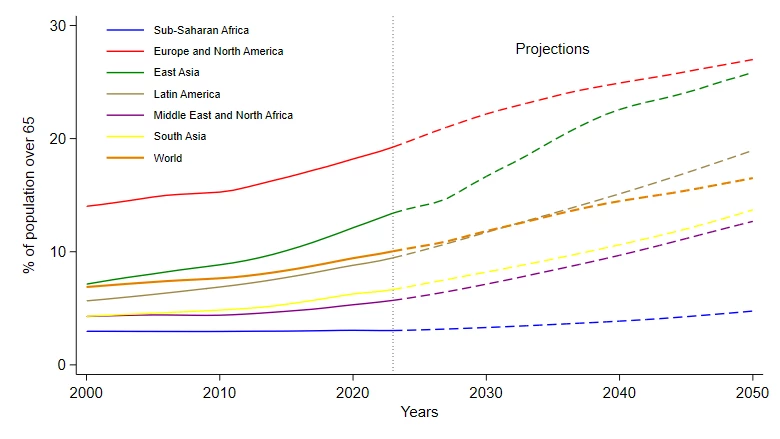 The rising elderly population in Europe and Central Asia is contributing to a reduction of the labor force.
The rising elderly population in Europe and Central Asia is contributing to a reduction of the labor force.
It may seem that the relentless march of artificial intelligence will destroy jobs, creating a glut of people unable to find work. Yet, of much greater concern for the emerging market and developing economies of Europe and Central Asia is the dramatic reduction of the labor force.
What is going on?
Many countries in the region are in the midst of a profound demographic crisis: lower fertility, declining mortality, large emigration, and the resulting population declines. The average fertility rate has declined from 2.8 children per woman in 1960 to 2 children by 1990 and to 1.6 children today, well below the replacement level of 2.1 children. In addition, emigration, particularly to the European Union (EU) has been large, but immigration from to Europe and Central Asia from outside the region has been modest.
As a result, since 1990, the populations of Ukraine and Bosnia and Herzegovina have dropped by 29%, Bulgaria by 25%, and Russia by 3%. And these declines are set to continue.
The region is also becoming older and loneliner. The proportion of people over 65 could reach or even exceed 25% by 2050 (Figure 1) in many countries. By the end of this century, a 65-year-old European will have half as many living relatives as a person of the same age in the 1950s.

Source: UN World Populaiton Prospects
The resulting changes in the age structure have economy-wide repercussions. Smaller numbers of working-age people will negatively affect labor markets and slow capital investment and GDP growth. Declining worker-to-retiree ratios and more years in retirement will strain government budgets and the sustainability of pension and healthcare systems. Without large government interventions, these negative tendencies will strengthen as the aging of the population accelerates. Indeed, the 2023 UN State of World Population report warns that if population decline continues, “whole countries or even the human population itself could ‘collapse.’”
Can policy address the problem?
Not fully. The underlying demographic shifts have been long-term and are driven by structural changes in economies and societies. Globally, population growth is down from almost 2% in 1960 to 0.8% today. The global fertility rate is similarly down by half over this period to 2.3 children per woman.
Four main policy directions need to be explored to help mitigate these demographic shifts in Europe and Central Asia.
One is support for higher birth rates. Such policies include direct financial incentives to families to have more children; the provision of childcare and housing for young couples; labor market reforms aimed at women with children; and efforts to make fertility treatments, like IVF, more accessible and affordable. Success stories in Armenia, Belarus, the Czech Republic, Georgia, and Latvia suggest that coherent pro-natal policies can indeed boost fertility. However, the results of such policies materialize only after several decades.
Ambitious pro-natal policies to even partially offset current demographic trends could also be very costly. In the absence of labor market policies, women and society face the trade-off between motherhood and participation in the labor market when the labor force is shrinking. Higher fertility rates might discourage older women from remaining in the labor force, adversely affecting the size and composition of the labor force.
Increased immigration is another policy. Migration is expected to be the driver of population growth in high-income countries over the next decades.
While large inflows of migrants might be seen as a simple solution for supplementing the labor force and improving worker-to-retiree ratios, countries will need very large numbers of migrants to offset population aging. For example, to maintain its current worker-to-retiree ratio by 2050, the EU would need to attract more than 100 million foreign-born migrants. Even pushing the current fertility rate of 1.46 to the replacement rate of 2.1, the EU would achieve only a modest increase in the worker-to-retiree ratio.
Bringing large numbers of migrants whose skills do not match the needs of destination countries might be fiscally prohibitive. Further, the costs and feasibility of measures to attract skilled migrants in competition with other countries could be significant. It is unclear whether there is a sufficient global supply of skilled migrants and whether sending countries would implement steps to retain their human capital. The fertility rates in sending countries are starting to decline, with the global supply of migrants projected to fall by 31.5 million below the demand by 2050.
Limits on the impact of automation on productivity in post-industrial economies and the number of older workers wishing to continue working after retirement also constrain the effectiveness of these policies.
Another avenue is bringing into the labor force a large number of young people who are neither in education, employment, or training (NEET). The share of NEET is about 20% in Romania and about 15% in Bulgaria and Croatia, just above the 12% average for the EU and the US.
We would argue combining pro-migrant policies and measures that improve labor market opportunities for women should be at the core of how the region responds to the “graying” demographics. And these policies need to be supplemented with interventions to increase labor force participation, especially among young populations that neither study nor work.



Join the Conversation